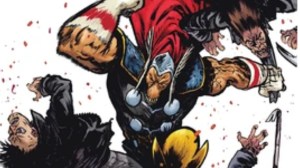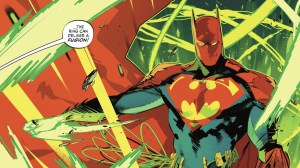Few characters in pop culture are as iconic as Frankenstein (or Frankenstein’s Monster, for those who prefer to be pedantic), so it’s no surprise that Image Comics is attempting to bring the character back from the dead in their new miniseries Universal Monsters: Frankenstein. Frankenstein, as played by Boris Karloff in the 1931 film based on Mary Shelley’s 1818 novel Frankenstein; or, The Modern Prometheus, is the latest Universal monster to be resurrected at Image, who previously told tales focusing on Dracula and the Creature from the Black Lagoon. As compared to other, more overtly nefarious figures, Frankenstein has always carried with him the sympathy of being misunderstood, having never asked for life nor knowing the difference between right and wrong. As teased in this debut issue, Universal Monsters: Frankenstein looks to break the icon down even further, reminding readers how he’s a character who is merely the sum of so many parts, with each issue set to explore the origins of those appendages.
Videos by ComicBook.com
In this first issue of the series, readers witness various iconic moments from Frankenstein lore, which includes grave robbing and Dr. Frankenstein uttering the seminal, “It’s alive!” when the doctor realizes the success of his machinations. Rather than simply retreading the components of the original story, writer and artist Michael Walsh and colorist Toni-Marie Griffen touch upon these narrative beats, but they do so by looking to the margins of this story, focusing instead on a young boy who had to witness his dead father’s hand being defiled in order to create Frankenstein’s abomination. With many more body parts to go, this journey is just the beginning of how the ungodly creation could serve as the manifestation of a community’s trauma.
Whatever medium it might be, creatives involved in any attempt to revive the Universal monsters are faced with the challenge of either adapting a story too liberally and risking that the experience will be repetitive or redundant, though if they aim to put too much of their own spin on a story, they can alienate longtime fans who think a reimagining could tarnish a character’s legacy. Luckily, Universal Monsters: Frankenstein manages to deliver the best of both worlds, as every time the reader will start to gloss over the story because they know what comes next, Walsh and Griffen pivot away to the characters on the outskirts of the tale. Despite not necessarily being billed as such, the comic book feels like it could offer the “unseen chapters” of a story that horror fans have known for the 200 years since Shelley’s original novel.
Walsh manages to stay authentic to the source material, finding just the right balance between contemporary and classic dialogue, leaning into the early stages of Dr. Frankenstein’s madness without ever exaggerating his eccentricities. Dr. Frankenstein thinks that by curing death, he can prolong life, so while his medical practices might be unconventional, it feels as though he’s doing it for the greater good as opposed to playing God just to see if he can.
Just as the line “It’s alive!” is inherent to a Frankenstein story, so is a gothic aesthetic, which Walsh and Griffen fully deliver. What makes the original movie and a majority of Frankenstein-inspired stories is the subtlety of the visuals, as the best versions of the character keep him rooted in the past as opposed to thrusting him inexplicably into a modern context. This allows the comic book’s art to embrace outdated mechanical devices that look just scientific and powerful enough to revive the dead, yet without having us question how one machine is capable of pulling off such a feat, while other panels jump between moonlit graveyards to rainy valleys to brick-laden fortresses.
This miniseries has been billed as telling the stories of the corpses defiled for the sake of science, but with only three issues to go and a number of extremities to explore, we can’t help but wonder how the creative team will manage to do justice to each new character’s history while also offering authentic conclusions. It seems as though this miniseries won’t necessarily be an anthology, with each issue exploring a different body part, but could rather shed insight to varying degrees on all of the pieces assembled to form the Monster.
Horror fans have seen countless versions of Frankenstein over the centuries, and while Universal Monsters: Frankenstein #1 doesn’t push the figure’s mythology into an entirely new realm, it both honors the Monster and his history while also hinting that there’s still a lot more to explore with the reanimated corpse. Both the writing and the artwork are evocative and accessible, no matter what your familiarity might be with the character, and fully honor Frankenstein‘s storied history. We look forward to future installments in which we hope we’ll get a bit more background on the unwilling victims who pieced the Monster together, which have the potential to re-contextualize the monster without betraying what we already know and love about him.
Published by Image Comics
On August 28, 2024
Written by Michael Walsh
Art by Michael Walsh
Colors by Toni Marie-Griffin
Letters by Becca Carey
Cover by Michael Walsh








